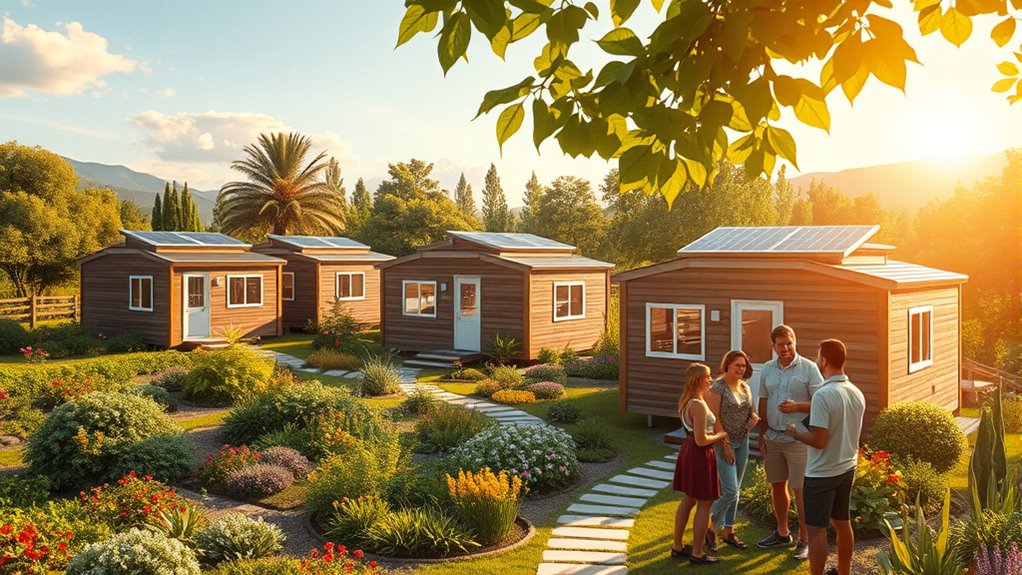To explore the tiny house movement in 2025, start by understanding the principles of minimalism and sustainability. Research eco-friendly building materials and engage with vibrant online communities on platforms like Reddit and Instagram. Attend workshops and expos for hands-on learning and networking. Familiarize yourself with local zoning laws and land options to guarantee compliance. You’ll find a wealth of resources and support in this growing community that could inspire your tiny living journey.
Key Takeaways
- Join online communities like Tiny House Talk and Reddit’s r/TinyHouses for resources, advice, and shared experiences in tiny living.
- Attend workshops and expos to gain hands-on experience, learn building techniques, and network with industry professionals in the tiny house movement.
- Research local zoning regulations to ensure compliance for tiny home placement and understand community guidelines affecting your building plans.
- Explore sustainable materials from local suppliers to minimize your environmental impact while building or renovating a tiny home.
- Follow social media platforms like Instagram and Pinterest for innovative tiny house designs and inspiration from fellow enthusiasts.
Understanding the Essence of Tiny Living
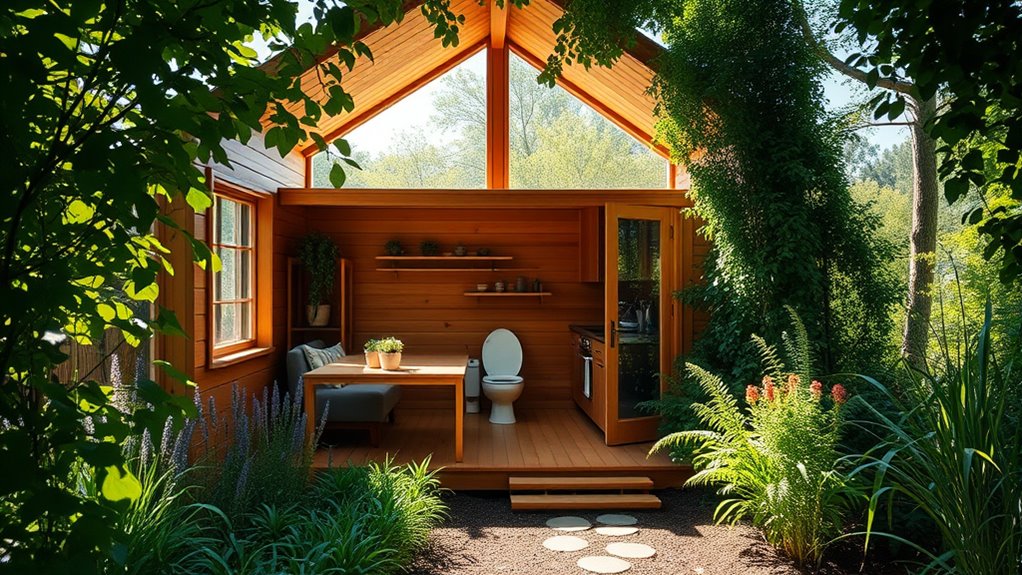
As you immerse yourself in the tiny house movement, you’ll quickly realize it’s all about embracing minimalism and sustainability.
Tiny homes, ranging from 100 to 400 square feet, are designed for efficient use of space, providing essential living features without the clutter. This lifestyle promotes financial freedom, with costs averaging between $30,000 and $60,000, which is considerably lower than traditional homes.
Many tiny houses utilize eco-friendly materials and advanced technologies, like solar panels and smart systems, enhancing energy efficiency.
Tiny houses embrace eco-friendly materials and cutting-edge technologies, boosting energy efficiency and sustainability.
As you explore this movement, you’ll discover how it reshapes community dynamics, fostering tight-knit neighborhoods that prioritize shared resources and intentional living. Establishing routines in tiny living can further aid in maintaining mental clarity and emotional resilience.
Tiny living isn’t just a trend; it’s a commitment to sustainable living and a simpler, more fulfilling life.
Researching Sustainable Practices and Materials
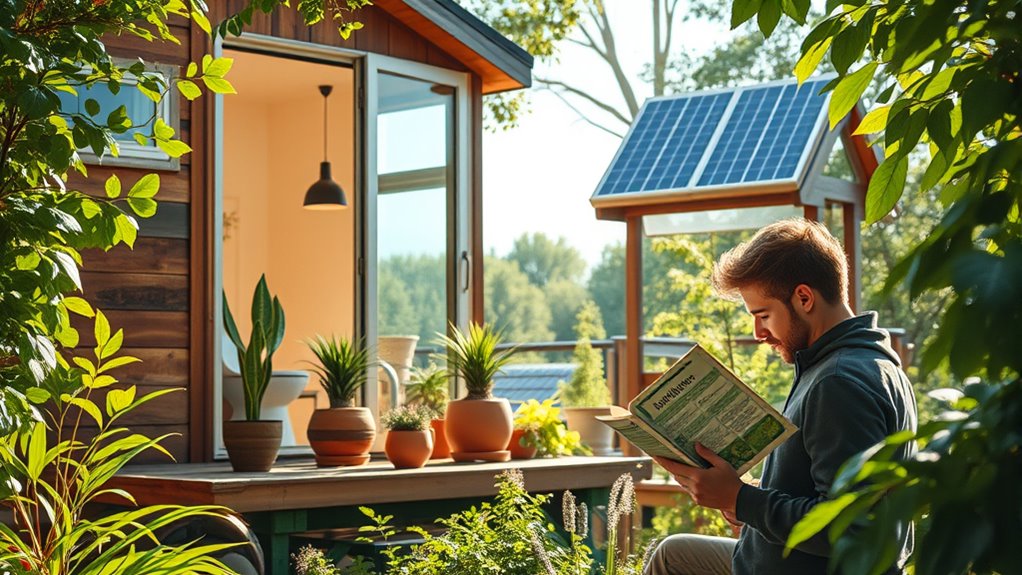
When you’re building a tiny home, choosing eco-friendly materials is key to minimizing your environmental impact. You’ll find that sustainable building techniques not only enhance durability but also create a healthier living space. Additionally, incorporating natural light into your design can further reduce energy consumption and improve overall well-being.
Eco-Friendly Material Options
While exploring eco-friendly material options for tiny homes, you’ll find a variety of sustainable practices that not only lessen environmental impact but also enhance your living space.
Using reclaimed wood and recycled steel markedly reduces the carbon footprint associated with new construction. Opt for low-VOC paints to promote healthier indoor air quality and minimize environmental impact.
Incorporate biodegradable insulation and low-carbon concrete to boost energy efficiency and durability. You can further enhance sustainability by integrating solar panels and composting toilets, reducing reliance on traditional utility systems.
Research local suppliers for sustainable materials, ensuring you source eco-friendly solutions that align with your commitment to responsible living in your tiny home.
Sustainable Building Techniques
Sustainable building techniques are essential for creating eco-friendly tiny homes that minimize environmental impact. To achieve this, research local suppliers for sustainable building materials like reclaimed wood, low-VOC paints, and recycled steel.
Incorporate energy-efficient systems, such as solar panels and rainwater harvesting, to promote off-grid solutions. Explore innovative options like biodegradable insulation and low-carbon concrete for durability and improved indoor air quality.
Consider advanced materials, including thermally treated softwood and high-performance thermal windows, to enhance energy efficiency and reduce heating and cooling costs.
Stay informed about emerging trends, such as smart ventilation systems and materials that neutralize air pollutants, ensuring a healthy living environment in your tiny home. Additionally, examine how modular housing can integrate sustainable practices to create adaptable living spaces for diverse needs.
Engaging With Online Communities and Forums

How can you tap into the wealth of knowledge available in online communities and forums dedicated to tiny house living?
Start by joining platforms like Tiny House Talk and Facebook groups focused on the tiny house community. These spaces offer invaluable resources, advice, and inspiration from seasoned tiny home dwellers.
Don’t miss out on Reddit’s r/TinyHouses, where you can engage in discussions about downsizing and share challenges with others on a similar journey.
Explore Instagram and Pinterest for innovative tiny house designs that can spark ideas for your own space.
Finally, participate in virtual meetups and webinars to connect directly with experts, gaining insights into sustainable living practices and the latest trends in tiny house living. Additionally, many community members share their experiences regarding construction time to help you better plan your tiny house project.
Attending Workshops and Tiny House Expos
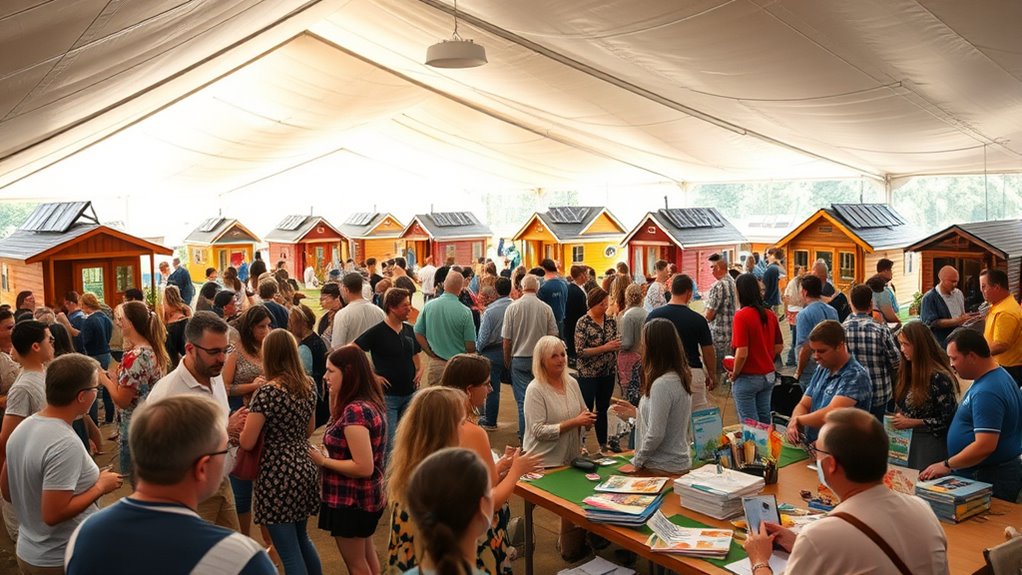
If you’re enthusiastic to dive deeper into the tiny house movement, attending workshops and expos is a fantastic way to gain hands-on experience and valuable insights.
Events like the Tiny House Expo and Tiny House Festival feature demonstrations on building techniques, design innovations, and sustainable living practices. You’ll discover various tiny home models and eco-friendly building options while learning about zoning regulations and financing strategies.
These workshops also provide excellent networking opportunities with industry professionals, builders, and fellow enthusiasts, fostering community connections.
Don’t miss the chance to tour tiny homes, where you can explore innovative designs and space-saving solutions firsthand.
Exploring Local Initiatives and Resources
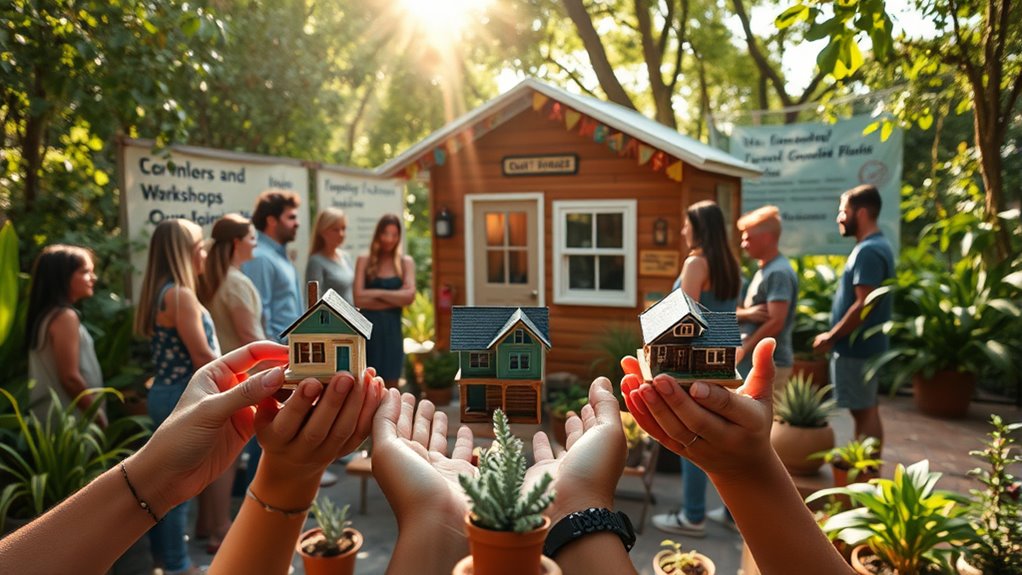
As tiny house living gains popularity, many cities are stepping up with initiatives that make this lifestyle more accessible.
You’ll find adjustments in local zoning laws that allow for the development of tiny house communities. These municipalities often create pilot projects to showcase tiny homes as affordable housing solutions, letting you experience tiny living firsthand.
Non-profit organizations and community groups provide essential resources for tiny house builders, including construction guidance and financial literacy programs tailored to your needs.
Don’t miss out on networking events and tiny house expos where you can connect with builders, designers, and fellow enthusiasts.
Embrace these sustainable housing options that promote a simpler, more intentional way of living in your community. Additionally, be aware that zoning laws can significantly impact where you can legally place your tiny home.
Navigating Zoning Regulations and Land Options
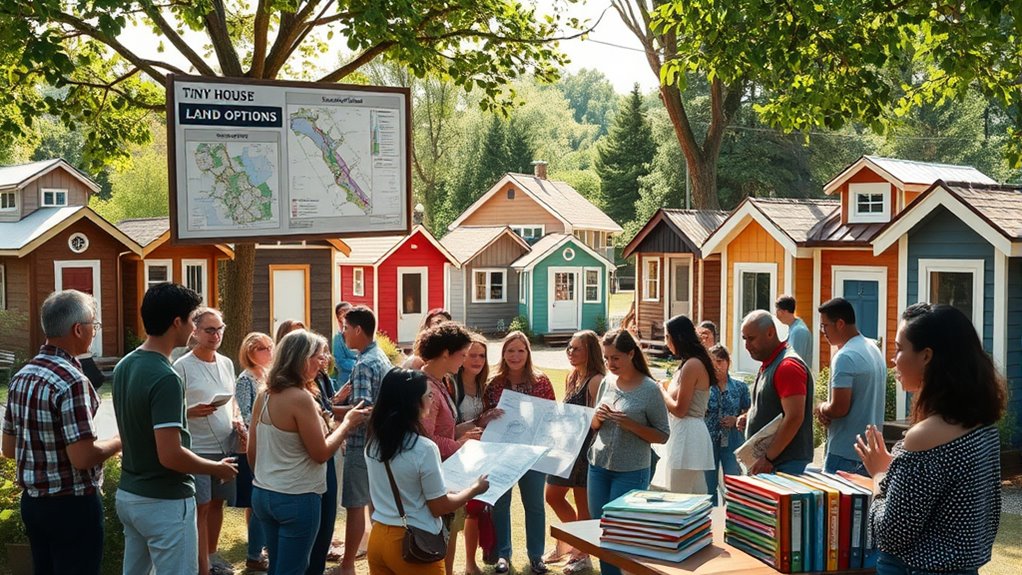
When you’re considering a tiny house, understanding local zoning laws is essential.
Many municipalities are adapting their regulations to embrace tiny living, so you’ll want to find land options that align with these changes.
Exploring community guidelines will help guarantee your tiny home fits within the requirements of your chosen area.
Understanding Local Zoning Laws
Maneuvering local zoning laws is essential for anyone considering a tiny home, since these regulations can vary widely from one municipality to another.
Before starting your tiny home project, research your area’s local regulations to understand zoning laws that may affect where you can place your tiny house. Some regions have specific tiny house zoning designations, allowing for permanent placement.
Be aware of minimum square footage requirements, as certain jurisdictions enforce size limits on residential structures, potentially excluding tiny homes.
Tiny house communities and RV parks also have their own zoning laws, so evaluate their legal feasibility. Engaging with local planning departments can provide insights into current regulations and potential changes that could impact your tiny home aspirations. Additionally, understanding state-specific regulations is crucial for compliance and ensuring a smooth building process.
Finding Suitable Land Options
Where can you find the best land options for your tiny home? Start by researching local zoning regulations, as these dictate the placement of tiny homes. Check for land use permits and any specific requirements, especially in urban areas. Rural land options often provide more leniency, allowing for flexible building arrangements. Tiny house communities are popping up across the country, offering established infrastructure and supportive regulations. Utilize online platforms and local real estate listings to find suitable land options that comply with zoning laws. Additionally, consider the importance of building codes and zoning laws, as they can significantly impact your tiny home project.
| Land Type | Key Features |
|---|---|
| Tiny House Communities | Supportive regulations, community feel |
| Rural Land Options | Lenient zoning, flexible arrangements |
| Urban Areas | Specific permits, higher restrictions |
Community Regulations and Guidelines
Finding the right land for your tiny home is just the start; understanding community regulations and guidelines is crucial for a smooth setup.
As you explore tiny house communities, make certain to research local regulations, which can include zoning laws and building codes that dictate minimum square footage or restrictions on tiny homes on wheels.
Knowing the difference between homes on permanent foundations and those on wheels can impact your land use options greatly. Engaging with housing advocates and local government planners can help you navigate these regulations effectively.
Many tiny house communities offer shared resources and amenities, making them appealing choices. Additionally, ensuring that your living situation complies with key elements of a successful co-parenting plan can enhance your overall experience and stability. Stay informed to guarantee your tiny living experience aligns with local rules and supports your dream lifestyle.
Frequently Asked Questions
Is the Tiny House Movement Growing?
Yes, the tiny house movement is definitely growing.
You’ll find that millennials and retirees are leading the charge, drawn by affordability and mobility. As awareness of sustainability and minimalism rises, more people are considering tiny homes as a viable solution to housing challenges.
Plus, evolving zoning regulations make it easier for you to embrace this lifestyle.
Tiny house communities are also emerging, promoting shared economies and reducing living costs for residents like you.
Is the Tiny House Trend Over?
Is the tiny house trend over?
Oh, sure! Let’s just ignore that it’s projected to be worth $5.8 billion soon.
You know, millennials and retirees are flocking to tiny living like it’s the latest avocado toast fad.
Sure, cities are changing zoning laws and creating tiny house communities, but who needs affordable, eco-friendly living anyway?
If you think it’s over, you might want to take a peek at the thriving tiny house revolution.
Are Tiny Homes Losing Popularity?
Are tiny homes losing popularity? Not at all! In fact, they’re thriving as more people embrace minimalist living and affordable housing.
You’ll find millennials and retirees alike drawn to this lifestyle, seeking community and sustainability.
With evolving regulations making tiny homes more acceptable, and smart technology enhancing their appeal, it’s clear that tiny homes are here to stay.
How Much Would It Cost to Move a Tiny Home?
Moving a tiny home can cost you between $1,000 and $5,000, depending on various factors like distance and weight.
Typically, you’ll pay around $2 to $3 per mile for transportation.
Don’t forget to account for additional expenses, such as permits, insurance, and utility reconnections, which could add another $500 to $1,500 to your total.
If your home’s on a fixed foundation, disassembly and reassembly might push costs over $10,000.
Conclusion
As you plunge into the tiny house movement, remember that it’s not just about downsizing; it’s a lifestyle rooted in sustainability and community. By connecting with others, attending events, and understanding local regulations, you’ll find endless possibilities for your tiny living journey. So, are you ready to embrace a simpler, more meaningful way of life? The world of tiny houses is waiting for you—take the leap and discover what it has to offer!
